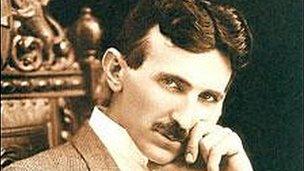Tesla museum campaign exceeds fund-raising target
- Published

Nikola Tesla wanted to build a tower to supply the entire world with wireless electricity
A museum dedicated to electricity pioneer Nikola Tesla is set to be built, after The Oatmeal website exceeded a target of raising $850,000.
Launched less than a week ago, the campaign was set up to buy Tesla's old laboratory in Shoreham, New York.
About 21,000 people have donated more than $900,000 (£570,000), with 39 days of the crowd-funding campaign to go.
The Serbian-American inventor is best known for his work on alternating current, radio, and electromagnetism.
"Wow, someone just donated $33,000 at the last minute and put us over our goal! $873,169 REACHED!" tweeted, external The Oatmeal creator Matthew Inman, who launched the campaign on the IndieGoGo crowd-funding website.
"With the matching grant from NY State, this puts us at $1.7m raised in six days to try and buy the property. FAN-GODDAMN-TASTIC," he added in another tweet, external.
Saving the lab
In 1905, Tesla built a 187ft (57m) tower in the town of Shoreham.
He hoped it would be a power station that would supply the entire world with free wireless electricity, prefiguring the wi-fi, 3G and other cable-free transmissions used in modern mobile phones, computers and cars.
But some time later, the scientist lost his funding, and in 1917 the Wardenclyffe tower was demolished to pay Tesla's debts.
A photographic film company bought the land and used it for nearly 48 years.
The site has recently been put up for sale, with an asking price of $1.6m.

A non-profit organisation aiming to buy the site wants to turn it into a museum dedicated to the inventor
A non-profit organisation, Tesla Science Center at Wardenclyffe, expressed interest, with plans to turn the old lab into a museum dedicated to the inventor.
But it had trouble raising money - and Mr Inman decided to help.
"The folks behind this project are a... non-profit organisation and they've spent the past 15 years trying to find a way to save this property," says the campaign's description, external on the crowd-funding site.
"This IndieGoGo account is linked directly to their bank and all the funds will go directly to them."
The non-profit group has to outbid another potential buyer "who wants to purchase the property [to] potentially tear it down or turn it into a retail establishment," Mr Inman wrote in his blog, external.
Tesla was born in present-day Croatia in 1856, and graduated from university in Graz, Austria. In 1884, he started working for the inventor Thomas Edison, already famous at the time, on transmitting electricity.
But the two scientists soon began to disagree about the fundamental aspects of their work, in what became known as the "war of currents".
They eventually fell out and went their separate ways.
'Wild man'
Edison worked with direct current (DC) - the kind produced by batteries, where electrons flow from negative to positive terminals.
But Tesla advocated alternating current (AC), where the current periodically changes direction.
Although the first commercial electric-power transmission, built by Edison, used DC, it is AC that now powers most households around the world.
Tesla was known as an eccentric character, nicknamed the "wild man of electronics".
Blacked out
Trying to prove the safety of his AC lighting system, he would light lamps in his hands by using his own body as an electrical conductor.
Tesla was certain he could develop enough power to "split the earth like an apple". During one of his experiments in Knob Hill, Colorado, he blacked out the entire city of Colorado Springs.
Once, he wirelessly lit 200 lamps from a distance of 40km (25 miles).
Despite hundreds of inventions and some of the most important scientific breakthroughs, Tesla died heavily in debt in 1943.
- Published2 July 2012
- Published21 July 2011